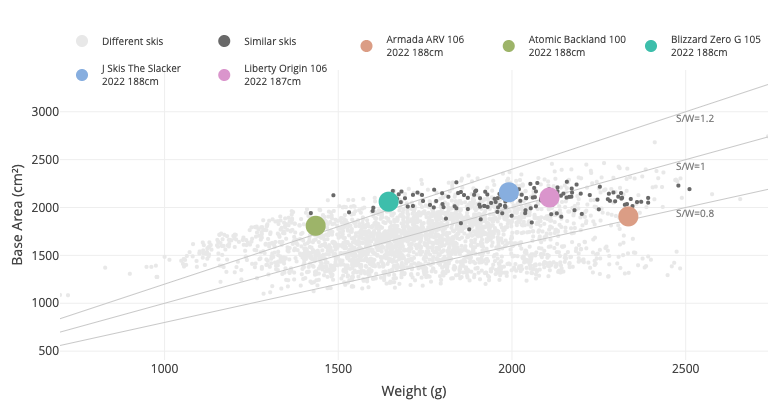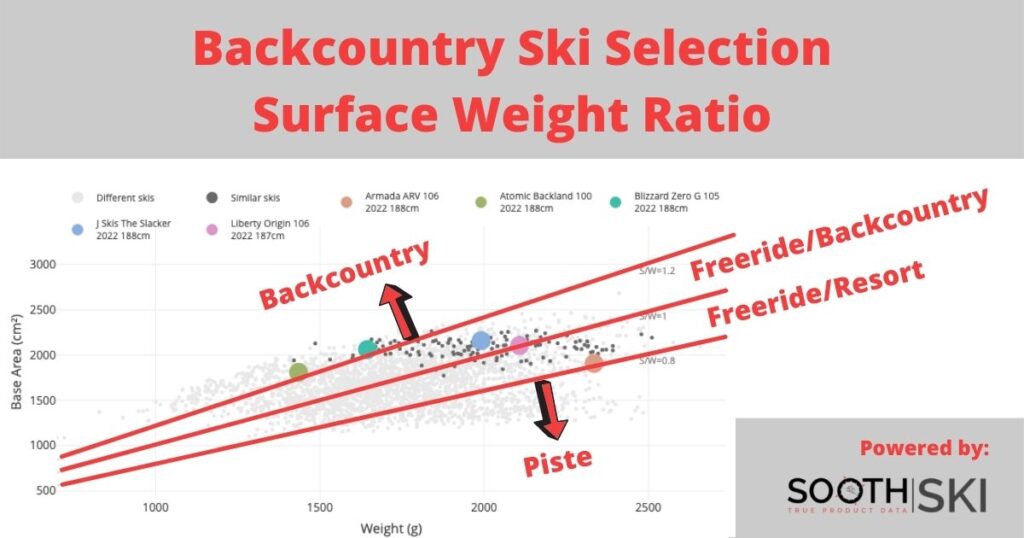Over the past few years, backcountry skiing has known an amazing increase of popularity. While 15 years ago I had to take a trip to Gear X in Vermont to find some gear, today, virtually every ski shop, carries a variety of backcountry skis, boots and related gear.
Shopping for the right gear can be a challenge and at SoothSki, we want to help you. One interesting measure that we use quite often is the Surface-to-Weight Ratio of skis. The surface of a ski gives you an idea of how well a ski will float, while its total weight is related to its damping and uphill abilities. The Surface-to-Weight Ratio allows you to compare very quickly the type of construction used in a ski, without having to consider its shape (e.g., length, width).
This article explains how this ratio can be used with our Ski Comparator application and what you should be looking for.
Why Is The Surface-to-Weight Ratio important?
A light ski is commonly used for backcountry skiing, since you need to carry the weight uphill. However, you probably also want a ski that has a large surface, so you can enjoy the powder snow. To combine both, it's logical to use a metric that allows to compare any option against each other.
What Is The Surface-to-Weight Ratio?
Wildsnow introduced this ratio several years ago and published a few comparisons. It's fairly simple to understand. Measure the surface of a ski and divide it by the weight. It's a great way to rapidly evaluate what is the intended use of a ski, regardless of it width or length.
How Do We Calculate Surface-to-Weight Ratio?
Getting the weight of a ski is simple, you can do this with any scale. Getting the surface is more difficult. I suppose that back in the days when skis were straight, it was easy to measure. One could use a measuring tape and approximate very well. Today, with the variety of shapes, it's more difficult. Luckily, our measuring machine measure the width at any point along the length of the ski and a quick computer script calculates the surface automatically for us!
How to use SoothSki Surface-to-Weight Comparison Charts
When you compare skis with our Comparator Application, you obtain a chart that compares the surface, the weight and the Surface-to-Weight ratio. The Surface-to-Weight ratio provides an easier way to compare the different categories of skis, and its units are squared cm per grams. We can split the results in 4 general categories (or many more if you want to!). While the limits of those categories are somewhat fuzzy and may evolve as skis become lighter, currently this is how we think about the different skis categories :
- Above 1.2 are skis that are very light considering their surface size and would be considered backcountry skis. Within this category, we find SkiMo skis that often score ratios above 1.3.
- Between 1.2 and 1 are where we find most freeride skis. They are light enough to use occasionally in backcountry, but also likely to have a construction robust enough to withstand aggressive skiing. These skis are often constructed with lighter materials like carbon fiber and light woods. Long and fat powder skis also often use lighter constructions to keep the total weight within reasonable limits.
- Between 1 and 0.8 are freeride skis that are more oriented towards lift-served skiing or all-mountain category. These skis are often constructed using heavier materials that have more damping (e.g., fiberglass, titanal, rubber, heavy wood cores). The closer to 0.8 would be the all-mountain skis with a narrower waist width.
- Below 0.8 is where we find most piste skis. They are narrow skis that use stiff and heavy constructions to deal with ice and have superior carving abilities at high speed.
Subscribe
Don't miss the next article. Follow our development. Get exclusive insights. Thank you for supporting us.
By subscribing, you accept our privacy policy that can be consulted at anytime here.
Example: How To Use Surface-to-Weight Ratio
In the chart below, I provide you with an example of how our Ski Comparator can be used. A search was performed to find skis from 21/22 that are around 188cm long with a waist width of about 105mm. Out of all the results (38 skis), I selected 5 skis that have very different Surface-to-Weight Ratios and therefore, should be considered to have very different purposes.
Atomic Backland 100
Clearly the lightest in this selection, the Atomic Backland 100 has a reputation to be a great choice as a versatile backcountry ski. It's identified as a backcountry quiver and our chart shows it very well.
Blizzard Zero G 105
Among the pioneers of lightweight skis, the Blizzard Zero G 105 is also identified as a backcountry ski. It's slightly heavier than the Atomic Backland 100, but also has more surface to float on. The resulting Surface-to-Weight Ratio is thus comparable to the Atomic Backland 100.
J-Ski The Slacker
J-Ski defines The Slacker as "a lighter ski that also charges hard, making it the least nerdy touring ski in the world". As per our chart, we can see that they are bang-on with the description. It is in the middle of the Surface-to-Weight Ratio for backcountry freeride skis. You can take them backcountry skiing but you still have some mass to charge.
Liberty Origin 106
Similar to The Slacker, but slightly heavier. I often say, when it's a difference of less than 200grams, it's less than a can of beer (the regular ones). But it can be important for you! As per the chart below, the Liberty Origin 106 is perfectly on the line between freeride/backcountry and freeride/resort (or all-mountain).
Armada ARV 106
As stated in most reviews, the Armada ARV 106 is a true all-mountain ski. Clearly, on the graph below, this is how it shows. Is has about the same surface as the Atomic Backland 100, but about twice the weight. This ski is made to charge anywhere, but you probably don't want to carry it too often uphill!

In Conclusion...
I understand measures, ratios and charts sound nerdy, but they provide very accurate information about skis. With only a quick glance, you can see where any model fits and this can help you make sound decisions on which part of your quiver will have lightweight backcountry bindings and which part should be more dedicated to resort (and occasional slackcountry).
We hope this helps and feel free to contact us for more information.
Affiliation & Relations With Shops
To help us further develop our measuring technology and our Ski Comparator Application, we have integrated some affiliate links and we also refer to shops who have welcomed us to measure the skis they sell. We may receive indirect compensation from shops if you use an affiliate link either from our website or our Ski Comparator Application. We may also refer skiers to shops that support our project by giving us access to measure skis. We thank you for helping us maintain our Ski Comparator Application 100% free.
You are also welcome to contribute with donations. Thank you for supporting us.





